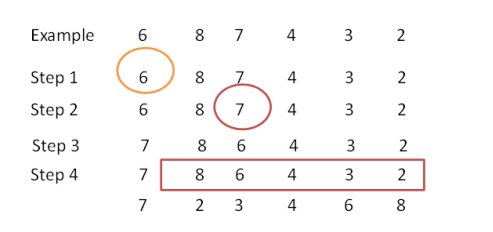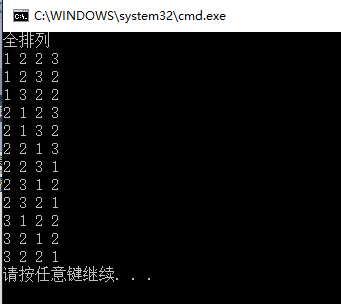全排列如果按字典顺序排好的话,我们知道其中的一个序列,就能推出下一个序列。比如说集合{1,2,3}的全排列按字典排序后如下:
1 2 3
1 3 2
2 1 3
2 3 1
3 1 2
3 2 1
当我们知道其中一个序列为{2,3,1}时,我们是可以推出下一个序列为{3,1,2}的,但是程序应该怎么写呢?主要分四步来找出下一个序列:
1.从右到左,找出当前序列中第一个违反递增规则的元素(相等不违反)记为pivot
2.从右到左,找出当前序列中第一个大于pivot的元素记为change
3.交换pivot和change的位置
4.将pivot位置(是交换之前的位置)右边的所有元素进行反转后得到的序列就是我们要的结果。
举个例子你应该就懂了:按上述方法求序列{6,8,7,4,3,2}的下一个序列的过程如下:
有了这个函数,我们只需要输入最小的序列然后不断求下一个序列,直到得到了最大的序列这样我们就能得到这个序列的全排列。其实STL已经为我们实现了这个函数next_permutation,所以如果是笔试我们可以直接用STL给的这个函数,但是要是面试的话还是需要我们自己实现这个函数。具体代码如下
#include "stdafx.h"
#include <iostream>
#include <vector>
#include <string>
#include <algorithm>
using namespace std;
template<typename Bidit>
bool my_next_permutation(Bidit first,Bidit last)
{
const auto rfirst=reverse_iterator<Bidit>(last);
const auto rlast=reverse_iterator<Bidit>(first);
auto pivot=next(rfirst);
while(pivot!=rlast && (*pivot>=*prev(pivot))) //第一步求pivot的位置
{
pivot=next(pivot);
}
if (pivot==rlast) //判断当前序列是否是最大序列,如果是就返回false,同时将序列变为最小序列
{
reverse(rfirst,rlast);
return false;
}
auto change=rfirst;
while(change!=rlast && (*change<=*pivot)) //第二步求change位置
{
change=next(change);
}
swap(*pivot,*change); //第三步交换pivot和change位置
reverse(rfirst,pivot); //反转pivot右边的所有的元素
return true;
}
int _tmain(int argc, _TCHAR* argv[])
{
//全排列
cout<<"全排列"<<endl;
int inputArray[]={1,2,2,3};
vector<int> inputVec(inputArray,inputArray+4);
vector<vector<int>> result;
do
{
result.push_back(inputVec);
} while (my_next_permutation(inputVec.begin(),inputVec.end()));
for (int i=0;i<result.size();++i)
{
for (int j=0;j<result[i].size();++j)
{
cout<<result[i][j]<<" ";
}
cout<<endl;
}
return 0;
}程序运行结果如下:
版权声明:本文为shineboyxxb原创文章,遵循 CC 4.0 BY-SA 版权协议,转载请附上原文出处链接和本声明。

